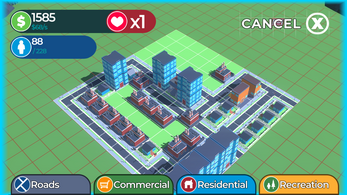
Idle City
Game Premise
Idle City is a mashup of a city builder and an idle income game! Players must strategically place buildings and roads to get the best possible income, while dealing with increasing costs as they progress.
Instructions and Hints
- All buildings must be adjacent to a road.
- Commercial buildings require population for their staff. Your population increases as you place residential buildings.
- Money is earned each second by the commercial buildings you've placed.
- Recreation buildings provide happiness which acts as a multiplier on your income per second.
- You can expand by buying plots of land around you.
Game Development Process
The Team
Idle City was developed over five business days by Aaron Malley, Jeremy McCurdy, and Anthony Mah.
Aaron was the game designer and lead developer. He was given the goal of creating a game concept around user generated content, and was free to interpret that how he saw fit. He arrived at the idea of creating a simplified city building like Sim City with idle game style mechanics.
Jeremy was the 3D modeller and support developer . He was responsible for modelling tile-able roads, buildings, and creating renders for UI previews. He also assisted with development of the UI.
Anthony was responsible for creating the game's UI design and assets. He came into the project half way through the week, so he had to get up to speed fast and work with a concept that was mid-production.
Ideation
Since it's not realistic to create a full blown city simulation in a week, the team had to look at the aspects of the genre they wanted to create, and what wasn't important. They also looked to lower scope mobile genres to see what might be a good fit. This is where the mashup of sim and idle game came in.
The city building elements the team wanted to retain were creative layout of the city, and an economy where building types relied on each other for resources.
The idle elements that were introduced was the steady income per-second, tiers of purchases that give greater rewards for greater costs, and exponentially growing costs.
These two concept play off each other very well. Players have to start by placing "tier 1" buildings, and growing their income to afford higher tiers of buildings. Each time a player purchases a building, its cost increases. If you place too many of one building type, it may become too expensive for you. This requires players to naturally diversify their city by mixing in buildings of various tiers.
This approach enabled us to have a game with a reasonably balanced game economy without a lot time spent on game balancing.
Changes During Development
The game concept didn't change greatly during development, however some features were added or omitted before we arrived at the final game.
The first of these was the road auto-tiling system. Originally we were going to have players place road tiles individually, meaning they would choose where to place a "T" or four way junction. While easy to develop and giving players a lot of control, it went against the more casual game ethos we were going for. Based on that, Aaron implemented a system that would automatically created road junctions based on the adjacent road tiles.
One major feature we omitted was the ability to bulldoze buildings. While we greatly wanted this, it would have had a major impact on the game economy. Since the game is based around income generated by buildings, and exponential growth of costs, players could run into scenarios where they demolished buildings that were generating income, thus making the player wait for extreme amounts of time to afford anything.
Bulldozing is a solvable problem, but it's an example of how we took our development scope into account when deciding what was truly important.
| Status | Prototype |
| Platforms | HTML5, Windows, macOS, Android |
| Author | REDspace Game Labs |
| Genre | Strategy |
| Made with | Unity |
| Tags | City Builder |

